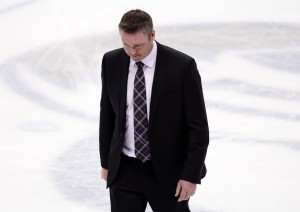What on earth has happened to the Colorado Avalanche?
A few weeks ago, I wrote about a team that looked reinvigorated. At that time, the Avs were streaking in a positive direction, eventually going on to record a point in 14 of 18 contests during a month-long stretch from Dec. 11 to Jan. 17.
Unfortunately as we sit here today, that column may have had more truth to it than just Colorado’s winning statistics. You see, one may recall that that same column noted that the Avalanche weren’t doing anything particularly new or different with their play, but instead had benefited from slightly better shot selection and improved goalie play.
However, wins are wins in any professional sport, and as long as Colorado was generating that all-important stat, most of us would be content to enjoy such a run of success. But the other shoe has now dropped for the burgundy and blue, with the Avs dropping four of their past five contests (full disclosure: four of those games could also be counted towards the team’s previous point streak) and perhaps more importantly in the long term, they averaged just two goals per game through the streak and were outshot (as usual) by a 35.4 to 28.2 shot per game margin.
But this isn’t a big “I-told-you-so.” The evidence in that column is out there for anyone to see, hardly “Eureka-type” material. It’s been rehashed because the entire episode got me thinking: Why do the Avalanche keep going back to a well that has generated so little success?
What I’m talking about is the offensive philosophy of three balanced scoring lines that the team has deployed since shortly after Joe Sacco took over as head coach of the Avalanche. The majority of NHL teams tend to stack two lines and use the other two in situational roles, so as not to dilute their top-end talent.
At the time it started, one would imagine that the idea came up as a result of Ryan O’Reilly’s unexpected early success with the club, leaving Colorado with three bona fide top-end centers in O’Reilly, Matt Duchene and Paul Stastny. With the later addition of Nathan MacKinnon, the Avs had committed themselves to attempting to balance out their lines, at least for the near future. But even after the fleeting success that the 2013-14 season brought the club, it’s hard to understand why they worked so hard to maintain three balanced lines over the offseason.
You see, last year represented the only success of the three balanced line system in an almost six-year experiment. When Sacco took over in 2009, the team would go on to end the year sixth in the NHL in goals per game. Since that time, they’ve ranked 18th, 25th, 26th, fourth and now 23rd in the NHL in that same stat. Even during last season’s run, the Avs were horrifically outshot on a consistent basis and even went through a month-long stretch of .500 hockey after the subtraction of just one (lesser, I might add) contributor in Steve Downie.
Yet despite that less than stellar track record, Colorado is back at it this season. Stastny departed in the offseason for St. Louis. With O’Reilly’s second ugly contract dispute with the team front and center, Joe Sakic and Patrick Roy had the perfect opportunity to sign and deal the young two-way center for an asset that could help them build a more traditional, consistent roster. Instead, they’re still stretching their talent to thin in what can only be described at this point as a poorly executed attempt to exploit Colorado’s altitude, similar to the way the Denver Nuggets have long preferred to try to run teams out of the gym.
It sounds reasonable in theory, but holes in the team’s reasoning begs the following two questions: First, the Edmonton Oilers have had top-10 overall picks in each of the past six seasons, spending all but one of those on forwards; where has all that offensive depth gotten them? Second, the Avalanche had perhaps the worst time of any NHL team in adjusting to the salary cap; what now makes them believe that they can field three top-end lines with a finite amount of money?
In short, there’s a reason that this philosophy is not widely practiced throughout the NHL. The Avalanche have tried for six years, yet what do they have to show for it?
With Colorado a long shot to make the playoffs in a tough division, now is the time to explore what the team can do to build a more traditional roster. The Avalanche are a team that has enjoyed plenty of success over the years without trying to reinvent the wheel. This is a multi-championship franchise. They don’t need cheap gimmicks to win a few extra regular season games.
The Avalanche need to abandon their attempt at balanced lines. It hasn’t worked in the past, and all it can do now is hamper the team’s bright future.



